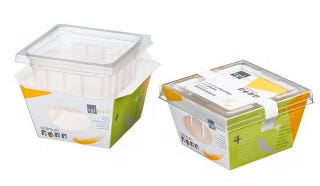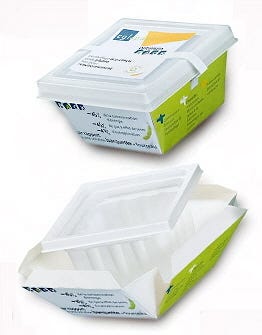January 30, 2014
 Developed in 2008 as the optimal environmental solution in packaging by CGL Pack, a small but very innovative packaging company in Annecy/France, the “Optimum Pack” finally encountered its first customer: the French manufacturer of diced cheese “Menus du Monde” (Menus of the World).
Developed in 2008 as the optimal environmental solution in packaging by CGL Pack, a small but very innovative packaging company in Annecy/France, the “Optimum Pack” finally encountered its first customer: the French manufacturer of diced cheese “Menus du Monde” (Menus of the World).
The brand Menus du Monde launches diced cheese products that can embellish salads. There are three versions: Ponte Vecio/tapenade/tomatoes, Feta cheese/tomato/pesto, and Emmental/artichoke/tomato.
CGL Pack developed a 300 ml (110 g of product) format which is now available as standard and complemented it with a 500 ml. The Optimum Pack can have a tailor-made, transparent or opaque cover which is, as well as the tray made from PCR APET, in other words post-consumer recycled amorphous polyester, in this case from recycled mineral water bottles. The thermoformed plastic tray sits in another tray, made from folding cardboard that provides the necessary rigidity and gives the printing possibilities. No glue is used. It is a real eco-design, as the packaging facilitates an easy separation of the two materials (cardboard and plastic) when discarded, as there is no glue or other fixative between the two.
 With this design CGL Pack has become the reference for optimal solutions in terms of ecology, i.e. a design which environmental impact is minimized while satisfying customer needs.
With this design CGL Pack has become the reference for optimal solutions in terms of ecology, i.e. a design which environmental impact is minimized while satisfying customer needs.
CGL Pack is also the one who took the initiative to develop a calculation method (3×3 Eco bilan) to quantify the environmental impacts of each new proposed packaging solution to its customers. A methodology audited and validated by Bio Intelligence Service.
The concept of the Optimum Pack is an eco-designed packaging for all types of packaging products but particularly solid food products. Its design is minimalist, compared to the traditional market solutions with a (thermoformed) plastic tray inserted in a cardboard sleeve. The Optimum Pack allows (according to the manufacturer) for a 45% energy consumption reduction, a 45% reduction of greenhouse gas emissions and a 47% reduction on the eutrophication impact (water pollution).
* At the other side of the world A&C Packers of Australia developed an Easy Pour Container for dangerous liquids. To bypass the generally necessary fluorination step, they designed a proprietary six-layer extrusion/blow-moulded HDPE container with the alternative barrier made of DuPont’s Selar polyamide, an amorphous nylon resin that needs no fluorination. Besides the special barrier construction, the container also offers a new 63-mm, Easy Pour “glug-free”, tamper-evident, wedge-seal neck design from Dorony Pty Ltd. An elegant solution to the glugging problem which …….. read the full article
At the other side of the world A&C Packers of Australia developed an Easy Pour Container for dangerous liquids. To bypass the generally necessary fluorination step, they designed a proprietary six-layer extrusion/blow-moulded HDPE container with the alternative barrier made of DuPont’s Selar polyamide, an amorphous nylon resin that needs no fluorination. Besides the special barrier construction, the container also offers a new 63-mm, Easy Pour “glug-free”, tamper-evident, wedge-seal neck design from Dorony Pty Ltd. An elegant solution to the glugging problem which …….. read the full article
About the Author(s)
You May Also Like


